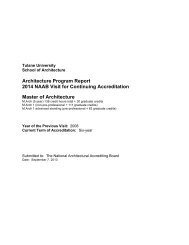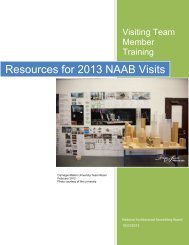Architecture Program Report Tulane University New Orleans ...
Architecture Program Report Tulane University New Orleans ...
Architecture Program Report Tulane University New Orleans ...
Create successful ePaper yourself
Turn your PDF publications into a flip-book with our unique Google optimized e-Paper software.
proper time management. One of the myths in schools of architecture is that<br />
time spent in studio is equivalent to great design or a higher grade. We<br />
recognize that this is not entirely true. Time management is essential, but<br />
productivity and efficiency is a major part of studio success. We recognize that<br />
studio is not just another class, that it requires a great commitment from<br />
students. It does and should consume a majority of students’ time; however, this<br />
should be properly balanced. We appreciate members of our student body who<br />
are passionate and committed to their designs, and we appreciate professors<br />
who maintain high standards of production and representation. However, this<br />
passion on the part of students should not overflow into the realm of excessive<br />
obsession - as this only plays to the detriment of other classes, well-being, and<br />
personal growth.<br />
We ask that professors be demanding but realistic about studio workload,<br />
especially in relation to the other 12 credits of classes present in the usual 18-<br />
credit workload of architecture students. Far too often students will “camp” in<br />
studio for hours or even days, neglecting food and classes, and the actual studio<br />
work produced will not reflect the large amount of time being spent in studio. We<br />
realize that professors and fellow students are wary of this behavior.<br />
Subsequently, we believe it is important for students to evaluate their time in<br />
relation to productivity and suggest that first years be required to keep a personal<br />
time log as they adjust to the demands of studio. This time log would not be<br />
given to the studio professor and would by no means be used to judge the value<br />
of work or the assignment of grades. Rather, it would serve as a personal tool for<br />
time management. The members of this committee, as students in our final year<br />
of school, reflect that a time log might have been a helpful tool for us to mark our<br />
progress and adjust to managing our time in the way that studio requires.<br />
Studio professors are perhaps the most influential people in a student’s<br />
career, as they are often the first to educate students about architecture as a<br />
whole. We believe that the dialogue between a committed and open-minded<br />
student and an educated, attentive, and open-minded professor is the greatest<br />
asset to the architectural education, and TSA is home to many committed<br />
students and respected professors. We believe that it is critical that every<br />
professor and every student respect each other’s time. Students have as much<br />
responsibility to be punctual and respect studio time as professors do in notifying<br />
students in advance of late arrivals and absences. We realize that disregarding<br />
punctuality is not unique to our school; many of us experienced it during the<br />
Hurricane Semester. Across the profession of architecture, punctuality seems to<br />
not be valued as highly as other personal traits. We feel that this is not a product<br />
of what could be called the “artistic personality” but a habit that must be<br />
eliminated.<br />
The influence that a professor has on his or her students extends beyond<br />
the design project and studio times. Even though this role may not be sought<br />
after by the professor, it is inherent in the professor student relationship. Within














